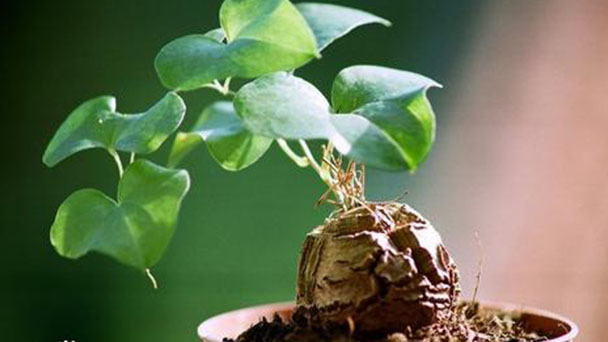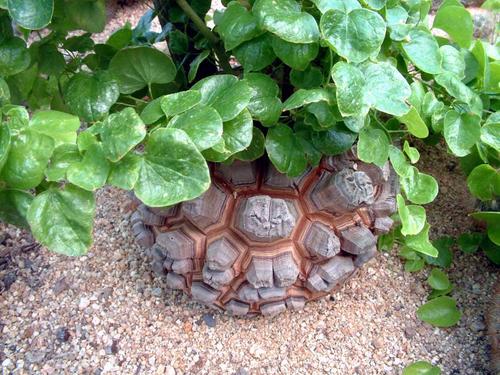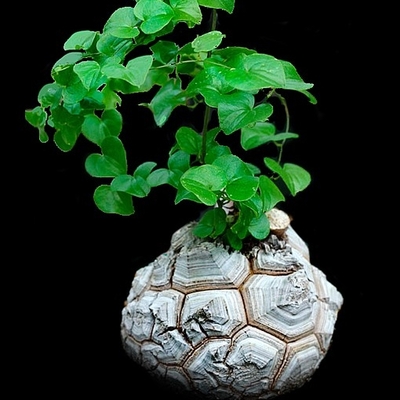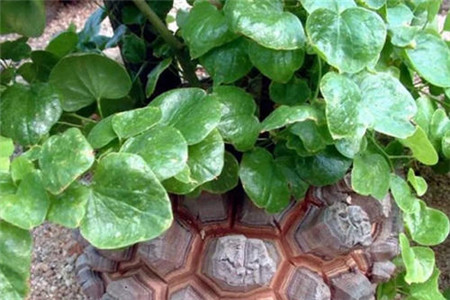Elephants Foot Plant (Dioscorea Elephantipes) Profile: Info & Care Guide
Written by Maggie
Dec 07 2021

Elephant Foot Plant (Dioscorea Elephantipes), also called turtle back, Elephant's foot, Hottentots' bread, elephant toe plant, elephant foot vine, is an ornamental plant, which gets its name because its skin cracks and resembles a tortoise shell when it grows into a plant. Elephant's feet are divided into two types: South Africa Aestivation and Mexico Hibernation.
Elephant foot plant is a perennial climbing herb. The plant is up to 6 meters high. Branches and tendrils grow in a clockwise direction. With hypertrophic tuberous roots, up to 90 cm long. Leaves are subcordate, entire, pale green. Male flowers are solitary, or arranged in a raceme; Female flowers are solitary in racemes, yellow-green;
Elephant Foot Plant Picture

Elephant Foot Plant Characteristics
Elephant Foot Plant (Dioscorea Elephantipes) is a perennial climbing herb. The plant is up to 6 meters high.Dioecy. Branches and tendrils grow in a clockwise direction. With hypertrophic tuberous roots, up to 90 cm long. Leaves are subcordate, entire, pale green. Male flowers are solitary, or arranged in a raceme; Female flowers are solitary in racemes, yellow-green; Ovary is inferior. Seeds are winged. The light brown root tubers of elephant foot plant are spherical when they are young, and when they are grown, the epidermis cracks and forms many independent pieces, like a stack of stones, like a tortoise shell, from which the name comes. Stem of Elephant Foot Plant is green, tendrils, 1 ~ 2 meters long. Leaves are cordite triangular, 6-7 cm long. The flowers are dioecious, small, 10-15 flowers open in clusters, and will give out a light fragrance like candy, but the number of female plants is less than that of male plants. Elephant Foot Plant is a deciduous vine, and a typical representative of large succulent plants at the base of the stem, which is very peculiar and rare.
Elephant Foot Plant Habits
Elephant Foot Plant grows in winter and is dormant in summer because its native land is quite dry in summer, so it is a "winter species". However, Elephant Foot Plant, a species native to Mexico, has almost the same stem traits as Elephant Foot Plant, but it grows in summer and is dormant in winter, so it is a "summer type species".The growth habits of the two are just opposite, so it is necessary to distinguish carefully before cultivation. The biggest difference between them lies in the difference of leaves. The leaves of Mexican Elephant Foot Plant are kidney-shaped, 8 ~ 10 cm long, and the leaf tips are obviously longer than those of a South African Elephant Foot Plant.
Elephant Foot Plant Care
1. Environmental care
How to raise an Elephant Foot Plant? First, let's see what kind of environment the Elephant Foot Plant likes. Elephant Foot Plant has high requirements on environmental temperature, and temperature is very important for the growth of Elephant Foot Plant.
2. Soil care
Elephant Foot Plant requires good permeability and does not contain too much humus, otherwise it is easy to rot or burn the roots.In addition, 1/3 of the stem must be buried in the soil when growing Elephant Foot Plant, so that it is easy to grow and the stem of Elephant Foot Plant grows faster.
3. Lighting care
Elephant Foot Plant likes half shade, generally in addition to winter daytime as much as possible to see the sun, early spring and late autumn appropriate light, the rest of the time should be placed in the indoor or balcony inside the ventilated place to protect from light.
4. Watering care
To water the Elephant Foot Plant, it is recommended to use the dipping method and should be controlled. Generally, the dipping method should not be used at one time, but usually dipping to the lower 1/3 to 1/2 of the soil in the pot.
5. Winter care
If the temperature in winter is about 5℃, the growth of Elephant Foot Plant will stagnate. In addition, Elephant Foot Plant will be maintained in a warmer place in winter to maintain the temperature needed for the growth of Elephant Foot Plant.
6. Summer care
Hot summer to half shade ventilation maintenance, every two weeks a soak. When watering, put it in an outside pot. Make sure the soil inside stays dry.

Elephant Foot Plant Species Classification
It itself comes in 1 variant: the Alpine Elephant Foot Plant. Also in the genus are the Mexican Elephant Foot Plant forest Elephant Foot Plant and the emperor turtle.
Elephant Foot Plant Taxonomy
Vines
Elephant Foot Plant is a deciduous vine, a typical representative of large succulent plants at the stem base, which is very peculiar and rare.
Elephant Foot Plant (Dioscorea Elephantipes) has a semicircular stem with a maximum diameter of 1 m. The stem surface is covered with thick, cracked hexagonal lumps or nearly hexagonal corky bark with many concentric polygonal wrinkles, similar to the growth rings of trees. Cork layer is a kind of protective tissue, it is impervious to water, airtight, elastic, can effectively protect the internal tissue, prevent the loss of water in the plant body, and has the effect of reducing the temperature in the plant body. Because there is a very thick layer of wood cork protection, so that the animal is difficult to gnaw, plays an effective role in self-protection. Stems clustered with slender, long, twining trailing stems, 1-2 m long. Leaves alternate, heart-shaped or reniform, about 2.5 cm long and 3.7 cm wide, thin green, with veins of 5 to 7.Racemes, small yellow-green flowers, only 4 mm in size, dioecious, after artificial pollination, the female flowers after bearing a very wide wing pinnate seeds.
Winter type plant
Elephant Foot Plant is a "winter type" plant, which has the habit of growing in cold season in winter and resting in high temperature in summer.Preferably warm, dry and sunny environment.
Summer dormant period stem usually only dry vine stem, sometimes can draw out thin and long vine stem, but not long leaves, should avoid hot sun exposure, put the plant in ventilated cool place maintenance, when the soil is too dry, can occasionally pouring water, but to prevent the soil too wet.
When the autumn weather turns cool, the leaves of Elephant Foot Plant will gradually grow up, the vines will also elongate, and may appear branching, at this time can be poured more water, in order to keep the soil moist, and the appropriate application of some thin liquid fertilizer, usually placed in the sun conservation.
Winter if you can maintain more than 15℃, and there is sufficient light, Elephant Foot Plant continues to grow, should be normal watering, fertilization. Around 10 ℃ when plant growth stagnation, but not the fallen leaves, water and nutrient consumption reduction, to stop the fertilization, watering also caution, and select the sunny noon relatively high temperature water, water is not too cold, do not feel too cold to his hand into advisable, see more sunshine during the day and night to pay attention to heat preservation, try not to let the fallen leaves, stems will be longer, the more and more hard.
When the temperature continues to fall, the plant will be deciduous, this time to strictly control watering, as long as the stem is not soft rot, such as warm weather will still germinate of new branches and leaves. The temperature below 5℃ is very vulnerable to freezing damage, if the long-term low temperature and humidity will lead to plant death.
Potted plants can be set up with wire supports for climbing vines. The basin should be replaced every 2 ~ 3 years. The sandy soil with medium fertility and good drainage should be used for the basin soil. The effect is better if some plant ash is mixed with it.
Elephant Foot Plant Distribution
Dioscorea Elephantipes is mainly distributed in South Africa and Mexico.
Elephant Foot Plant Uses
Elephant Foot Plant is one of the most famous succulents, representing both stem succulents and dioscorea succulents. Botanical gardens should be collected as a type, but also available for some hobbyists to collect and cultivate.

Latest Updated
- Benefits of Bugleweed - 7 Science-backed Health Benefits
- Bugleweed Dangers & Side Effects - Is It Poisonous?
- How to Plant Evergreen Trees - What You Should Know
- When to Plant Evergreens - Grow Guide for Evergreen Trees
- 12 Wonderful Evergreen Shrubs for Your Garden
- 12 Popular Evergreen Plants with Pictures for Beginners
- When And How To Prune A Lilac Bush Like a Pro
- How to Grow & Care for Lilac Vine (Hardenbergia Violacea)
- Japanese Lilac Tree (Syringa Reticulata) Care & Propagation Guide
- Shumard Oak Pros and Cons - What to Know
Popular Articles
- Winter maintenance of Antirrhinum Majus
- How to Grow Terminalia Mantaly Tree
- How to Grow and Care for Crossostephium Chinense
- How to grow Antirrhinum Majus in spring
- Peristeria Elata (Dove Orchid) Profile: Info & Care Guide
- Underwatered Snake Plant (Sansevieria Trifasciata) - Signs And How To Fix
- How to Care for Brazilian Jasmine Plant (Mandevilla Sanderi)
- How to Grow & Care for Graptopetalum Purple Delight in Summer
- Rosa Chinensis (China Rose): Plant Growing & Care Tips
- How to Care for Baby Sun Rose (Aptenia Cordifolia)